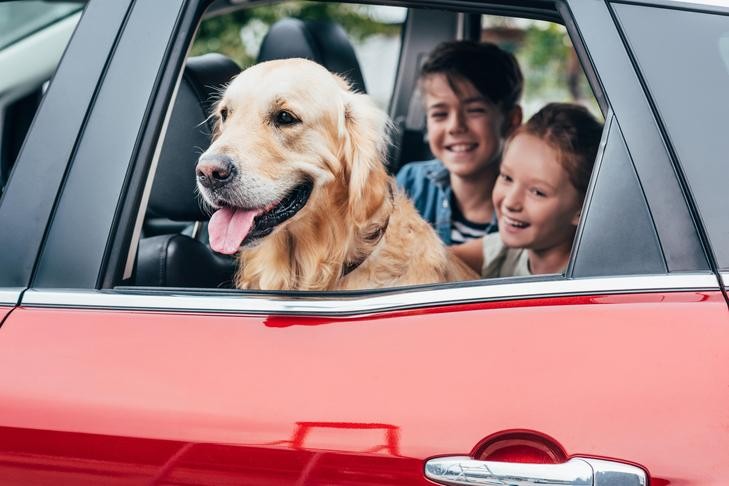Taking your dog on a car trip can be a wonderful experience for both of you, turning a simple journey into a fun-filled adventure. However, ensuring your furry friend is safe and comfortable during the ride requires careful planning and preparation. Whether it’s a short trip to the park or a long road trip, knowing How To Travel With A Dog In A Car is essential for a smooth and enjoyable experience for everyone involved. This guide provides comprehensive tips to make car travel with your dog safe, stress-free, and fun.
Pre-Trip Health and Safety Checklist
Before you embark on your car travel with your dog, a health check-up is paramount. Schedule a visit to your veterinarian to ensure your dog is fit for travel. Confirm that all vaccinations are current, especially rabies, and obtain their shot records, which may be needed for travel, particularly when crossing state lines or for accommodation check-ins. Discuss your travel plans with your vet to address any concerns about your dog’s health and suitability for travel. It’s also wise to ask if your dog is prone to motion sickness and discuss preventative measures if necessary. Remember, not all dogs are travel enthusiasts, and your vet can offer insights into your dog’s temperament for travel.
To maintain your dog’s well-being throughout the journey, pack a travel kit with essentials. This includes a sufficient supply of their regular dog food to avoid dietary upsets. Carry bottled water to prevent stomach issues from unfamiliar water sources. Don’t forget any medications your dog requires, ensuring you have enough for the entire trip and a bit extra, just in case.
Alt text: Happy Golden Retriever dog sitting calmly in the backseat of a car with two smiling children, highlighting family car travel with pets.
Ensuring Safe Car Travel with Dog Crates and Carriers
For the safest way to travel with a dog in a car, consider using a dog crate or carrier. A crate is not just for air travel; it’s also an excellent safety measure for car rides. It confines your dog, preventing them from distracting you while driving and protecting them in case of sudden stops or accidents. Ensure the crate is appropriately sized—large enough for your dog to stand, turn around, and lie down comfortably.
When selecting a dog crate for car travel, prioritize features that enhance safety and comfort. Look for a sturdy crate with handles for secure carrying and without interior protrusions that could harm your dog. The crate should have adequate ventilation on multiple sides to ensure fresh airflow. A leak-proof bottom lined with absorbent material will help manage accidents and keep your dog dry and comfortable. For added safety, the crate should be well-labeled with “Live Animal” stickers and arrows indicating the upright position. Clearly mark it with your name, address, and phone number for identification. Inside the crate, make it cozy with a comfortable crate pad, a favorite toy, and a water bottle specifically designed for travel crates.
Dog Identification: A Must for Car Travel Safety
Proper identification is crucial when you travel with a dog in a car. Accidents happen, and even the most well-behaved dog can become lost in unfamiliar surroundings. Ensure your dog wears a sturdy collar with identification tags at all times. The tags should include your dog’s name, your name, and your permanent home phone number. Including proof of rabies vaccination on the tag is also a good practice. If your trip is extended, consider adding a temporary tag with the contact information for your travel destination.
Microchipping offers a permanent form of identification for your dog, greatly increasing the chances of reunion if they get lost. Ensure your microchip information is up-to-date with your current contact details. It’s also wise to bring a recent photograph of your dog with you. In the unfortunate event that your dog becomes lost, a picture will be invaluable in helping others identify them. Keep a copy of your dog’s health and vaccination records handy as well.
Alt text: Calm Sealyham Terrier dog relaxing inside a spacious and secure travel crate, demonstrating comfortable and safe pet containment for car journeys.
Making Car Rides Comfortable for Your Dog
Acclimating your dog to car travel gradually is key to ensuring they are comfortable on longer trips. Start with short drives, perhaps just around the block, and progressively increase the duration. Make these initial experiences positive by associating car rides with pleasant destinations, like a park or a favorite walking trail.
During car travel, always use a dog seatbelt, car seat, or safety harness. These restraints are designed to protect your dog and prevent them from moving around the car, which can be distracting and dangerous. Just like humans, dogs need to be properly secured in a vehicle.
Ventilation is vital for your dog’s comfort during car rides. Ensure the car is well-ventilated by opening windows slightly or using the air conditioning, especially in warm weather. If your dog is in a crate, make sure it’s positioned to receive good airflow. To minimize the risk of carsickness, avoid feeding your dog a large meal right before traveling. However, always ensure they have access to fresh water. Plan for frequent stops – every two to three hours – to allow your dog to exercise, relieve themselves, and drink water. Always clean up after your dog during these stops to be a responsible pet owner.
Crucially, never allow your dog to ride in the open bed of a truck. This is extremely unsafe and can lead to serious injuries. Equally important, never leave your dog unattended in a parked car, particularly on warm days, as temperatures inside a vehicle can rise rapidly to dangerous levels, even with windows partially open. If you must leave the car, ensure someone stays behind with your dog.
Alternative Travel Methods and Considerations
While this guide focuses on how to travel with a dog in a car, it’s worth briefly considering other travel methods. If your destination is far, flying might seem quicker, but it can be more stressful for dogs. Airlines have specific regulations for animal travel, often requiring health certificates and specific crate types. Smaller dogs may be allowed in the cabin in a carrier, while larger dogs usually travel in the cargo hold. Always check airline policies well in advance.
For train travel, options are even more limited. Amtrak, for example, only permits small dogs under 20 pounds on certain routes and with restrictions. Bus travel with dogs is generally not allowed on major interstate bus lines like Greyhound, although service animals are exceptions. If considering boat or cruise travel, policies vary significantly by cruise line, and pet-friendly cruises are rare. For international travel with pets, regulations become even more complex, often involving specific health certifications, quarantine periods, and breed restrictions. Thorough research and planning are essential if you’re considering these alternative travel methods.
Top Tips for a Smooth Car Trip with Your Dog
To make car travel with your dog as smooth as possible, preparation is key. Before you leave, train your dog to relieve themselves on various surfaces, not just grass. This adaptability is incredibly useful during travel stops where grass might not be readily available. Pack a generous supply of poop bags for easy clean-up during your journey.
To keep your dog entertained and reduce anxiety during car rides, bring along a mix of familiar and new toys. Puzzle toys can be particularly effective at keeping them occupied. Remember to pack collapsible travel bowls for food and water; these are space-saving and convenient. Get your dog used to eating and drinking from these bowls at least a week before your trip. Consider giving your dog only bottled water throughout your travels to avoid potential stomach upsets from different water sources.
Finding Dog-Friendly Hotels for Road Trips
When planning a road trip, securing dog-friendly accommodations is vital. Research hotels and motels along your route and at your destination that welcome dogs. Many establishments have pet policies, which may include size restrictions or additional fees. Always confirm their pet policy before booking.
Once you arrive at a dog-friendly hotel, be a considerate guest. Inquire about designated dog walking areas and always clean up after your pet. Keep your dog as quiet as possible to respect other guests, and never leave your dog unattended in the hotel room. Upon arrival, take the time to puppy-proof your hotel room, just as you would at home. Ensure electrical cords are out of reach and check for any potential hazards left by previous guests.
Remember, it’s a vacation for you and your dog. Travel can be stressful, but your dog will mirror your emotions. Stay calm and relaxed to help your dog remain calm. If you are anxious, your dog is likely to become anxious too. Be mindful that some dogs simply do not enjoy traveling. If your dog exhibits significant stress or anxiety at the thought of travel, or during short practice car rides, consider if it might be kinder for them to stay home with a trusted dog sitter. Ultimately, the goal is to ensure that any travel, especially car travel, is a positive experience for both you and your canine companion.

